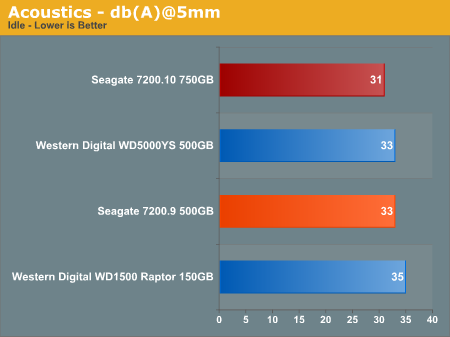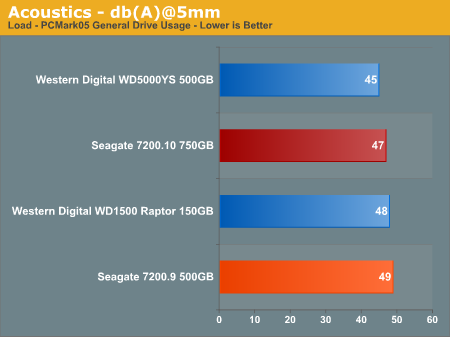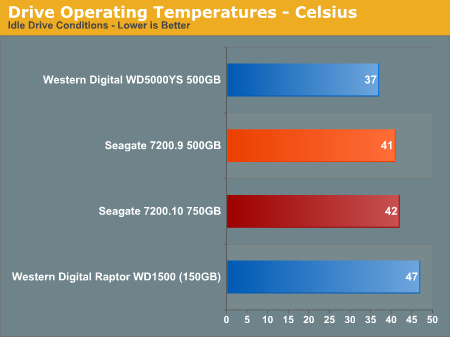Seagate Barracuda 7200.10 750GB: Size Does Matter
by Gary Key on May 18, 2006 9:00 AM EST- Posted in
- Storage
Acoustics
We have revised our acoustics testing methodology. Our acoustic test utilizes our standard test bed components but we implement AMD's Cool'n'Quiet technology and turn off the case fans to isolate as much case noise as possible during testing. Our OCZ power supply is virtually silent in these tests along with our fanless Asus 7600GS video card providing a further decrease in our case's ambient noise levels.Our acoustic tests are designed to measure the decibel levels while the system is at idle and also under load while running the General Hard Disk Drive Usage benchmark within PCMark 2005. We found through trail and error this particular benchmark produces controlled readings across a wide range of applications within the benchmark. This particular benchmark utilizes 60% reads and 40% writes within the trace playback file.
The measurements are taken at a distance of 5 millimeters from the rear and front of the drive being tested in order to minimize surrounding environmental noise. (Obviously, you won't have your head less than a centimeter away from the hard drive in normal computer use, but the important thing is the relative noise levels at this distance.) The reported measurements are based on an A-weighted decibel score that measures frequencies similar to the way the human ear responds to sound. We take a total of three measurements for each test. We then subtract the high and low scores and arrive at our findings by reporting the remaining score.


Seagate has advertised that the 7200.10 product is quieter in comparison to Barracuda 7200.9 in both idle and seek modes due to further refinements in their "Softsonic" motor technology. During our testing we came to a slightly different conclusion based upon our subjective test methodology. We found the 7200.10 drive recorded slightly better acoustic results in the instrument testing than the Seagate 7200.9 500GB drive but was subjectively louder than the 7200.9 500GB drive under load and almost matched our WD1500 Raptor in its very audible tone during full read requests.
This was surprising as the 7200.10 had the lowest idle rate of 31dBA in testing with full load tests generating a noticeable but not earth shattering 47dBA. The drive is basically a "silent" component in our case during idle conditions with only the occasional disc whirling but at full load the drive does generate a noticeable, almost thumping sound. In fact, although two of the drives tested are considered louder by our test equipment, the noise tone was slightly heavier which elicited our immediate attention to it. Of course, tone comments are generally very subjective so this drive could be considered quiet at full load when compared to other drives.
Thermals
Our thermal tests utilize sensor readings via the S.M.A.R.T. (Self-Monitoring, Analysis and Reporting Technology) capability of the drives and are reported by utilizing the Active SMART 2.42 utility. We test our drives in an enclosed case environment without the front fan operational to simulate temperatures that could conceivably be reached in a SFF or HTPC case design. We typically find the reported numbers drop anywhere from 18% to 25% on average when the front fan is operational.

We expected the 750GB 7200.10 drive to run very warm due to its size and platter count. The drive ran cooler than we expected, but the casing did become very warm to the touch - almost hot actually - which had us concerned until we noticed the reported numbers. Using the drive's integrated SMART thermal sensor and Active SMART we were able to monitor temperatures that went from 42°C at idle to 55°C under full load. These results were recorded in our enclosed Gigabyte case without the front fan operating to simulate the effects of utilizing drive in a small enclosure for HTPC duties or possibly a poorly ventilated case.
We then activated the 120mm fan in the front of the case and watched the full load temps quickly drop to 44°C and after a cool down period of 15 minutes the idle temps dropped to 37°C with full load testing resulting in 47°C readings. We would highly recommend some type of cooling in front of the drive, especially in a SFF or HTPC case. Though the temperatures we reached without a fan are well within the operating range of the drive, it is always preferable to keep hard drives cool to prolong their life, especially at a $500 price point.
The surprise showing once again is the Western Digital WD5000YS drive with reported temperatures at idle of 37°C and 45°C at full load. The WD Raptor 1500 has the ability to sizzle some bacon with idle temps at 47°C and full load at 58°C with a hardy recommendation of adding a fan directly in front of this unit. The Seagate 7200.9 500GB falls in the middle of the pack with temps at idle of 41°C and under full load at 53°C. While the temperatures of the 7200.9 in our testing show an advantage without cooling, the drive actually ran hotter than the 7200.10 when both were cooled with the front case fan. Our recorded temperatures after the same cool down period (ambient room temp equal) resulted in 38°C readings at idle and 49°C readings at full load.










44 Comments
View All Comments
JakeBlade - Friday, May 26, 2006 - link
Interesting that this drive has a MADE IN SINGAPORE label instead of Seagate's usual MADE IN CHINA junk.ElFenix - Friday, May 19, 2006 - link
no reason to upgrade from my SE16, i see.i'd like to see a couple more drives in tests, such as the latest hitachi.
Gary Key - Friday, May 19, 2006 - link
The reason we did not include the Hitachi unit is we have the revised 500GB unit arriving shortly and as mentioned in the article we will have a complete 500GB roundup with the new 7200.10 also. It will take some time to build the database with the revised test suite as we also have additional application timer tests coming shortly.
The performance across most of the recently released mainstream drives is so close now that it comes down to a personal decision on warranty, reliability, thermals/acoustics, and capacity for the most part. However, drives like the Raptor and RE2 series do make things interesting for SATA on the desktop as did this drive for a PVR fanatic. ;-)
ElFenix - Friday, May 19, 2006 - link
i'd also like to see audio tests from a little bit further away. 5 mm doesn't give a realistic idea of how loud it will be sitting 3 feet away on the floor. plus, for all i know where you place the microphone is extremely important when at 5 mm.Gary Key - Friday, May 19, 2006 - link
There is no one good area to measure the acoustics as you never know where the PC will be located, what type of case, fan noise, or ambient sounds are present. I can tell you that a drive that is loud at 3mm~5mm will be loud at three feet with all things being equal. Sound tones are also very subjective, the dull thumping sound the drive has under load might be perfectly acceptable while the higher pitched clicking sound of a Maxtor will be unbearable for some people.
We place the two mics at different points on the drive to ensure a consistent recording point, we assume most people will utilize a horizontal mounting point with the rear of the drive facing the case front, although we test the drive facing the case side also as this cage design is becoming very popular. The tone of the drive can change dramatically with the addition of rubber washers between the drive and the mount points.
Thanks for the comments. :)
jhvtoor - Friday, May 19, 2006 - link
Temperature measurement using S.M.A.R.T. is not reliable. The sensor and electronics on the harddrive are used, en they are not calibrated.
I am using the freeware "HDD Health" utility to monitor the SMART information. It reported the drive temperature of my desktop is 12 degrees celcius immediatly after winXP boot, while the room temperature is 19 degrees.... I am not using cooling techniques on this drive. This can only be explained by an inaccurate temperature measurement of this drive.
I would suggest to use one an independent measurement instument in the future. Attach the sensor in the middle of the cover plate.
Gary Key - Friday, May 19, 2006 - link
Hi,1. We have found S.M.A.R.T. to be "fairly" accurate along with our capture utility. We know it is not perfect but it allows us a consistent measurement of each drive in testing. In our 7200.10 test ActiveSmart reported a temperature of 26c after boot, room temp was 22c. We put the drive through 15 minutes of light usage, let it idle for 15 minutes, and then report this number as our idle number. All of the drives we have tested have followed the same pattern with a consistent idle reading after this usage, the idle temp will be the same 15 or 30 minutes later. If you stress the drive, you will see the temps rise accordingly and then fall back to the standing idle temp during the cooldown phase.
2. One drawback is the temperatures are not "real" time, there is a delay built in, this is why on the load test (also idle) we loop PCMark05 several times and then take the reported temperature at the end of the session, generally the high temperature was actually reached in the previous loop.
3. We have have tried using a sensor, infrared, and other methods with varying results. The problem is each section of the drive will report a different number. When we utilized a sensor on the top plate, the temps varied from drive to drive with the same model being tested. Each supplier uses different materials for their casings so that creates greater variables, it just is not consistent enough to report.
toattett - Thursday, May 18, 2006 - link
Apparently,If I want a speedy drive, I buy the raptor.
If I want a super large drive, I buy the new 750GB Seagate.
If I want good performance and good amount of stoarge, I buy the 500GB WD.
Missing Ghost - Thursday, May 18, 2006 - link
The pictures for the noise level are wrong. You put the dbA level as if it was a linear scale. It's not that way, the space between 0dB and 10dB should be smaller than the space between 10dB and 20dB. That way it will show more clearly the difference between the noise levels. It's a logarithmic scale.Gary Key - Thursday, May 18, 2006 - link
Our current graph engine will not allow us to do this type of scale manipulation. We will probably have to utilize a Microsoft Excel chart in the next article. We agree with you, just not possible with the internal engine at this time although we are working on a new one.